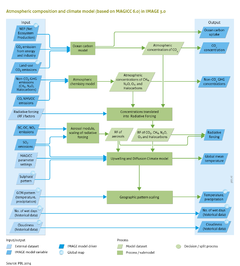Atmospheric composition and climate/Data uncertainties limitations: Difference between revisions
Jump to navigation
Jump to search
Oostenrijr (talk | contribs) No edit summary |
Oostenrijr (talk | contribs) No edit summary |
||
| Line 20: | Line 20: | ||
For the spatial distribution of climate change, most models agree that the changes will be largest at higher latitudes. However, there is a large degree of uncertainty for changes in precipitation, with models even disagreeing on what would be a sign of change in many regions ([[Meehl et al., 2007]]). This uncertainty in the spatial patterns of climate change can be taken into account by applying pattern scaling for temperature and precipitation based on a range of AOGCMs in IMAGE. | For the spatial distribution of climate change, most models agree that the changes will be largest at higher latitudes. However, there is a large degree of uncertainty for changes in precipitation, with models even disagreeing on what would be a sign of change in many regions ([[Meehl et al., 2007]]). This uncertainty in the spatial patterns of climate change can be taken into account by applying pattern scaling for temperature and precipitation based on a range of AOGCMs in IMAGE. | ||
In addition to CO<sub>2</sub> concentrations and climate change, atmospheric composition is relevant in some IMAGE components. Air pollutants are used to calculate the effect on human health (Component Human development). The effect of ozone on crop yields has been explored but is not yet part of the standard model set-up ([[Chuwah et al., | In addition to CO<sub>2</sub> concentrations and climate change, atmospheric composition is relevant in some IMAGE components. Air pollutants are used to calculate the effect on human health (Component Human development). The effect of ozone on crop yields has been explored but is not yet part of the standard model set-up ([[Chuwah et al., 2015]]). | ||
===Limitations=== | ===Limitations=== | ||
Although coupling to an AOGCM is not workable for integrated assessments, some {{abbrTemplate|IAM}}s use an Earth System Model of intermediate complexity for climate modelling. This allows for more detail and consistency in climate change impacts and feedbacks, but is fixed to one representation of the system, not accounting for the large uncertainties. Using the simple climate model MAGICC 6.0 enables research on the consequences of parameter values outside current emulated AOGCMs. For example, the impact of high climate sensitivity values beyond the range found in AOGCMs (2 to 4.5 °C) can be studied ([[Müller et al., in preparation]]). This extends the range of uncertainty covered by the IMAGE model in projections of future climate change and the related impacts. | Although coupling to an AOGCM is not workable for integrated assessments, some {{abbrTemplate|IAM}}s use an Earth System Model of intermediate complexity for climate modelling. This allows for more detail and consistency in climate change impacts and feedbacks, but is fixed to one representation of the system, not accounting for the large uncertainties. Using the simple climate model MAGICC 6.0 enables research on the consequences of parameter values outside current emulated AOGCMs. For example, the impact of high climate sensitivity values beyond the range found in AOGCMs (2 to 4.5 °C) can be studied ([[Müller et al., in preparation]]). This extends the range of uncertainty covered by the IMAGE model in projections of future climate change and the related impacts. | ||
}} | }} | ||
Revision as of 15:59, 10 August 2015
Parts of Atmospheric composition and climate/Data uncertainties limitations
| Component is implemented in: |
|
| Related IMAGE components |
| Projects/Applications |
| Models/Databases |
| Key publications |
| References |
